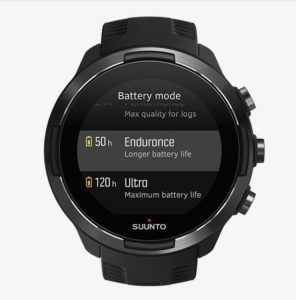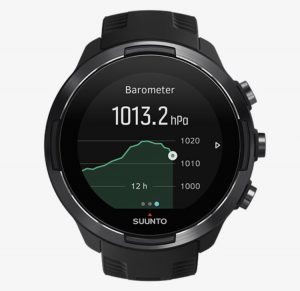 Our reviews are 100% organic. We do not accept payment for reviews or bundle with advertising budgets. In most cases, the brand is providing the product to our reviewers free of charge.
Our reviews are 100% organic. We do not accept payment for reviews or bundle with advertising budgets. In most cases, the brand is providing the product to our reviewers free of charge. By Annie Trent
Basic Summary: The Suunto 9 is the next generation in GPS watches geared towards endurance athletes who need extended duration battery life without sacrificing GPS accuracy. It is the first Suunto to feature FusedTrack technology which combines GPS tracks with movement data to maintain accuracy even at a lower tracking rate. Functionality is user friendly for those familiar with Suunto devices, and maintains all of the premium navigation features that people have come to expect.
MSRP: $599 without heart rate belt, $649 with heart rate belt
General:
- Weight: 81g/2.86 oz
- Dimensions: 50 x 50 x 16.8 mm/ 1.97 x 1.97 x 0.66″
- Strap width: 24 mm
- Water resistance up to 100m
- Vibration alerts
- LED backlight and configurable backlight
- Alarm clock (does not include a silent alarm option)
- 24/7 continuous HR monitoring
- Sleep tracking
Training and Navigation
- Battery life:
-
- 25 hours in performance mode
- 40 hours in endurance mode
- 120 hours in ultra mode
- Three data screens available during an activity
- Percentage battery indication
- Intelligent battery charge reminder
- Intelligent battery mode can be changed during an activity to save battery
- Barometric altimeter
- Altitude profile on watch interface
- Maps, terrain, and topography on watch interface
- Altimeter including total descent and ascent on watch interface during an activity
Connectivity:
- Functionality from Movescount app:
- Customize data screens
- Download GPX routes to watch
- Data transfer to Strava
- Functionality from Suunto app:
- Step, activity, and sleep tracking data
- Bluetooth compatibility with phone notifications which include texts and the apps on your phone

There are three GPS settings to choose from at the start of your workout: Performance (tracks every second), Endurance (every minute) and Ultra (every 2 minutes). The cool thing about these three modes is that they can be changed mid-workout if the battery starts to get low. The watch will also prompt you to switch modes if you forget to charge your watch and suggests which battery mode would be best for the remainder of the workout. The Suunto 9 adapts to your running habits, including what days you typically run and how many miles you run. For example, if you do a long run on Saturdays, the Suunto 9 will eventually recall your average mileage and suggest which GPS mode to switch to if your battery isn’t fully charged. It will also prompt you to charge your battery before anticipated long efforts.

Wrist heart rate sensor lights
The most distinctive innovation on the Suunto 9 is FusedTrack technology, which maintains your movement accuracy, even in long-duration ultra mode. By using the internal gyroscope, compass, heart rate monitor and accelerometer data, the watch fills in the gaps between satellite pings to create an accurate plot of your run. The FusedTrack technology is only used in ultra mode which is supposed to last 120 hours, but there are other factors such as the lights, heart rate monitor and altimeter, which will lessen the life of the battery. The FusedTrack technology isn’t 100% accurate, but for a setting that doesn’t use GPS, it gets pretty close.
The interface of the watch is a mix of touch screen and buttons, which I found a little confusing. I wasted five minutes at the trailhead trying to figure out how to start my run. The touch screen won’t let users operate everything, and arrows indicate when you need to push a button. With the buttons performing 100% of the functions, they are much easier to use when your hands are compromised.
Small runners should be aware that the Suunto 9 is fairly large in size with the face being almost two inches in diameter, along with large, protruding side buttons. While wearing the watch on a long mountain run, I noticed halfway through that the buttons and built-in heart rate monitor had dug into my wrist. This required me to stop and switch the watch, making sure that the three buttons were facing up my arm and cinching it tightly so it wouldn’t bounce and cause discomfort. This was a bummer because I wanted to test the battery life of the Suunto 9 while running the Wasatach 100, but decided to wait until the last 25 miles to avoid chafing.
 Compatible with most smartphones, the Suunto 9 will upload your workouts to the Movescount and Suunto app. The Movescount app is not the most user friendly, and it takes a good amount of time to upload your run. Having to upload workouts onto two similar apps with many of the same features is discouraging, but the Suunto app is where you can manage all your navigation features, such as creating and viewing heat maps of popular routes.
Compatible with most smartphones, the Suunto 9 will upload your workouts to the Movescount and Suunto app. The Movescount app is not the most user friendly, and it takes a good amount of time to upload your run. Having to upload workouts onto two similar apps with many of the same features is discouraging, but the Suunto app is where you can manage all your navigation features, such as creating and viewing heat maps of popular routes.
The Suunto 9 retains all the features of the Ambit and Spartan series watches and operates in a similar manner to those other devices, which makes it very user friendly. When changing the settings on the watch, you’d have to use the Movescount app on older models to change the GPS or sport mode settings, but the Suunto 9 allows you to change the them directly on the watch.

Suunto has always placed an emphasis on advanced navigation capabilities, and the Suunto 9 maintains all of these great features that users have come to expect. You can view route profiles on your watch, including elevation, prior to or during your run. You can also zoom in on the map, track progress with bread crumbs, view your directional orientation and log points of interest along the way. Another great feature is the capability of receiving barometer warnings if a storm is approaching. The full set of navigational features makes the Suunto 9 ideal for adventure racers or backpackers.
The Suunto 9 Baro is now available at www.suunto.com as well as numerous retailers and online.


1 comment
Wore my S9 through the 35 hours of UTMB without any sort of wrist hitting or any nagging problems. I have unusually petite wrists and seem to not notice the timepiece at all. Great read, thanks for the info.
Comments are closed.